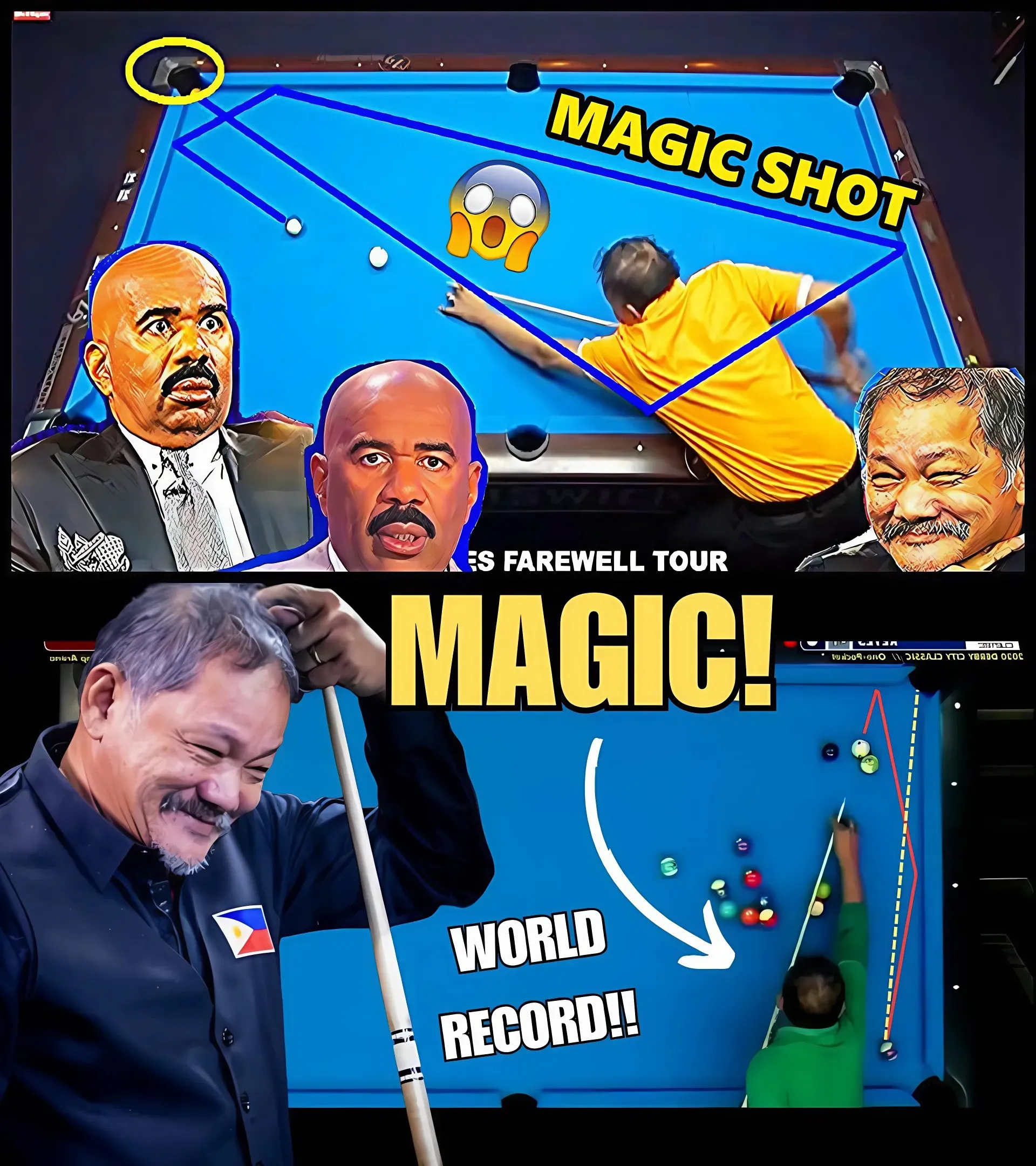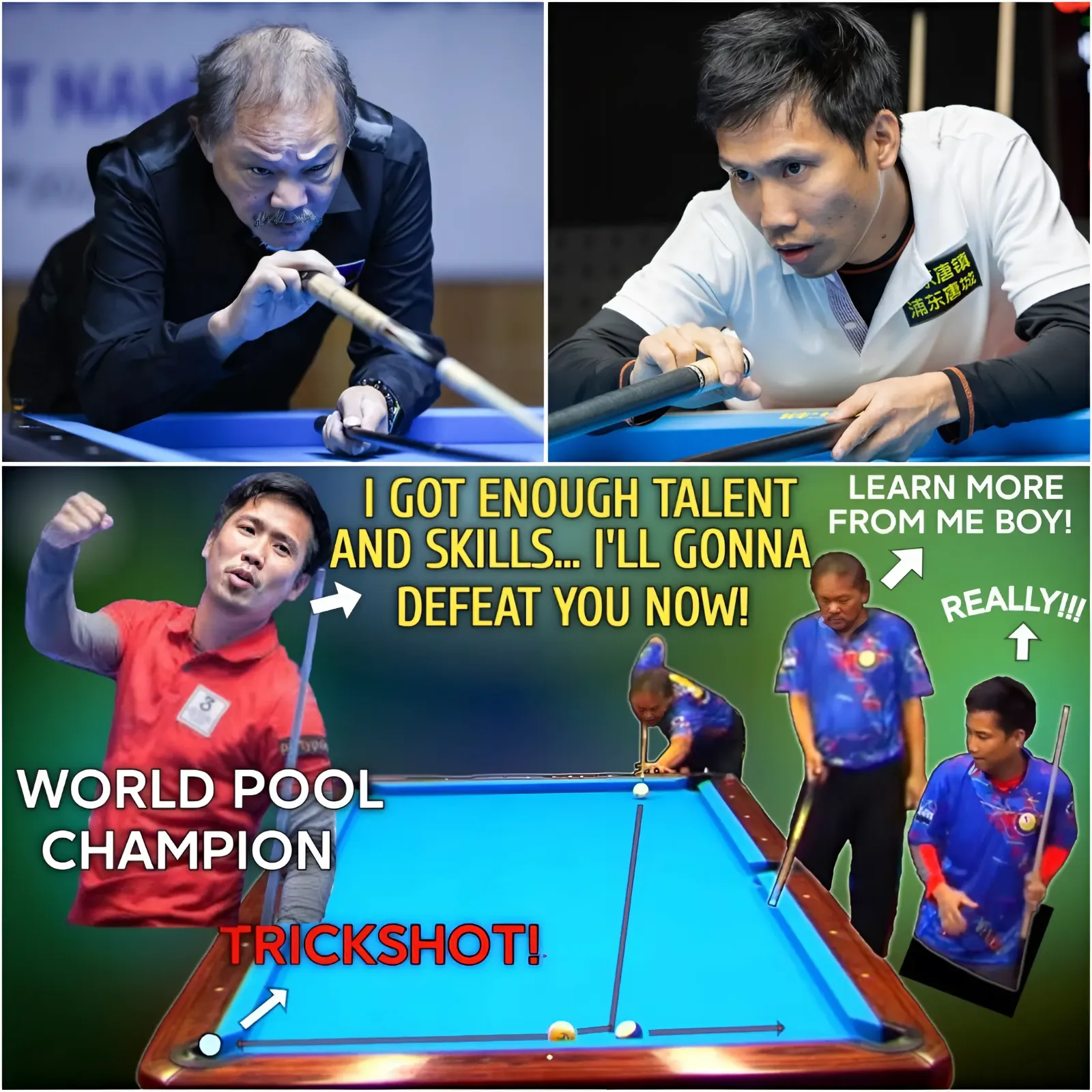The world of billiards is one of strategy, skill, and subtle psychological warfare. For decades, Efren "Bata" Reyes has been a towering figure in this arena, a maestro of the cue who has mesmerized audiences and opponents alike with his seemingly supernatural abilities. Known affectionately as "The Magician," Reyes' prowess at the table has earned him a legendary status, making him a revered and, at times, a feared competitor.
However, in a dramatic turn of events, the American billiards community has been stirred into action, rallying against the Filipino phenom in a collective declaration of challenge.
What led to this unprecedented movement was a combination of national pride, competitive spirit, and a desire to reclaim dominance in a sport that has seen Reyes set the standard for excellence. This narrative explores the intense build-up, the key players involved, and the explosive confrontations that followed.
VIDEO :
The spark that ignited the American players' resolve came from a high-stakes international tournament where Reyes once again displayed his exceptional skills, effortlessly dispatching a series of top-ranked American players.
The tournament, held in Las Vegas, was a showcase event, drawing the best talent from around the globe. Reyes’ performance was nothing short of spectacular, as he weaved his magic across the felt, leaving a trail of defeated opponents and awestruck spectators.
Among those spectators were several prominent American players, including Shane Van Boening, Earl Strickland, and Johnny Archer. These players, themselves legends in the sport, watched as Reyes dismantled their compatriots with an almost casual ease.
The loss stung deeply, not just as individual defeats but as a collective blow to American pride in the sport. Van Boening, known for his precision and mental fortitude, took the defeat particularly hard.
His respect for Reyes was immense, but the desire to see an American rise to challenge the Filipino legend burned brightly within him.
The aftermath of the tournament saw heated discussions and soul-searching within the American billiards community. Players and fans alike took to social media, forums, and interviews, expressing their frustration and determination to reclaim the top spot.
It was within this atmosphere of heightened emotion and competitive fervor that a plan began to take shape. The American players, led by Van Boening, Strickland, and Archer, decided it was time to issue a direct challenge to Efren Reyes – a showdown that would pit the best of American talent against the legendary Magician.
The announcement of the challenge was made during a press conference in New York City, a city with a rich history in billiards. The media buzzed with excitement as Van Boening stepped up to the podium, flanked by Strickland and Archer. The room was filled with journalists, fans, and representatives from the billiards community. Van Boening's voice was steady but filled with conviction as he laid out the challenge.
"Efren Reyes is without a doubt one of the greatest players this sport has ever seen," Van Boening began, his tone respectful yet resolute.
"But it's time for us, the American players, to step up and show that we can compete at the highest level. We are issuing a direct challenge to Reyes – a series of matches that will determine once and for all who the true masters of the table are."
The challenge was met with a mixture of excitement and skepticism. Reyes' dominance was well-known, and many wondered if the American players could indeed pose a serious threat to him. However, the challenge also injected a fresh wave of energy into the sport, promising a series of thrilling encounters that would captivate audiences worldwide.
Efren Reyes, ever the gracious competitor, responded with characteristic humility. In a video message, he accepted the challenge with a smile, his eyes twinkling with the excitement of new competition.
"I am honored by this challenge from my American friends," he said. "It is through such contests that we all grow and become better. I look forward to meeting them on the table and giving my best."
The stage was set for a series of matches that would become some of the most talked-about events in billiards history. The format was designed to test every aspect of the players' skills – from straight pool to nine-ball, from one-pocket to eight-ball. Each match was meticulously planned to showcase the diversity and depth of the competitors' abilities.
The first match took place in the historic Steinway Billiards in Astoria, New York. The venue was packed with fans, the air thick with anticipation.
The opening game was straight pool, a format that demanded precision and endurance. Reyes, with his vast experience and strategic mind, was in his element. Van Boening, however, was determined to make a strong start.
From the break, it was clear that this was going to be a contest of epic proportions. Reyes' first shots were flawless, his cue ball control impeccable. He quickly established a lead, pocketing balls with a seemingly effortless grace.
Van Boening, unfazed, responded with his own display of skill, methodically working his way through the table. The score remained tight, with neither player able to gain a decisive advantage.
As the match progressed, the tension in the room grew. Each shot was met with hushed anticipation, followed by bursts of applause. Reyes and Van Boening pushed each other to their limits, showcasing not just their technical abilities but their mental resilience. In the end, it was Reyes who edged out a narrow victory, his experience proving to be the crucial factor. The crowd erupted in cheers, recognizing the high level of play from both competitors.
The next match shifted to nine-ball, a game that required a blend of power and finesse. This time, it was held at the iconic Hard Times Billiards in Los Angeles. Earl Strickland, known for his fiery temperament and aggressive playstyle, faced off against Reyes. Strickland had a score to settle, and his intensity was palpable.
From the outset, Strickland's aggressive break set the tone. He pocketed two balls on the break and quickly set about clearing the table. His shots were powerful, his positioning precise. Reyes, however, remained unflappable. When it was his turn, he countered Strickland's aggression with a series of calculated safeties, forcing Strickland into difficult positions.
The match was a rollercoaster of emotions, with both players exchanging the lead multiple times. Strickland's passion and intensity were matched by Reyes' calm and strategic approach. The final rack saw Strickland make a critical error, leaving Reyes with a clear shot to the nine-ball. Reyes seized the opportunity, sinking the ball and securing his second victory in the series.
As the series continued, Johnny Archer took his turn against Reyes in a one-pocket match held in Chicago's historic Chris's Billiards. One-pocket, a game of strategy and patience, was a true test of both players' tactical acumen. Archer, known for his meticulous planning and execution, was determined to turn the tide.
The game unfolded like a chess match, each player carefully considering their moves. Archer's strategy was to keep Reyes on the defensive, using tight safeties and precise shot-making to control the flow of the game. Reyes, however, was a master of adaptation. He responded with his own blend of offense and defense, slowly chipping away at Archer's lead.
In a pivotal moment, Archer executed a brilliant bank shot, pocketing a ball that seemed impossible. The crowd erupted, sensing a potential upset. However, Reyes, unfazed, responded with a series of masterful shots that turned the game in his favor. In the end, Reyes' ability to read the table and anticipate Archer's moves proved decisive, earning him another hard-fought victory.
The American players, despite their losses, remained resolute. The series had become more than just a challenge; it was a journey of growth and learning. Each match, regardless of the outcome, was a testament to the skill and determination of both Reyes and his American challengers.
The final match of the series was set to take place in Las Vegas, the same city where the initial spark had ignited this fierce competition. The format was eight-ball, a game that required a blend of strategy, precision, and nerves of steel. All eyes were on this final showdown, as it represented the culmination of months of preparation, practice, and intense competition.
Van Boening, having started the challenge, was chosen to represent the American side in this decisive match. Reyes, ever the gracious competitor, was ready to face his young challenger once more. The atmosphere in the arena was electric, the air thick with anticipation.
From the break, it was clear that both players were in peak form. Reyes executed a powerful break, scattering the balls across the table. He quickly pocketed a series of balls, establishing an early lead. Van Boening, however, was undeterred. His shots were precise, his strategy flawless.
As the match progressed, the tension in the room grew palpable. Each shot was met with hushed anticipation, followed by bursts of applause. Van Boening's determination was evident in every move he made. He played with a level of focus and intensity that matched Reyes' calm and calculated approach.
In the final moments of the match, the score was tied, and both players had only a few balls left to pocket. Van Boening executed a brilliant safety, leaving Reyes with a difficult shot. Reyes studied the table, his mind working through the possibilities. With a deep breath, he executed a shot that seemed impossible, pocketing the ball and setting himself up for the win.
The crowd erupted in cheers as Reyes sank the final ball, securing his victory in the series. Van Boening, though disappointed, approached Reyes with a smile, extending his hand in a gesture of sportsmanship. The handshake was met with a standing ovation, the audience recognizing the high level of skill and sportsmanship displayed by both players.
In the aftermath of the series, the American players reflected on their journey. While they had not been able to dethrone the legendary Reyes, they had grown as players and competitors. The experience had brought them closer together as a team and had reignited their passion for the sport.
Reyes, in his interviews, spoke with humility and respect for his challengers. "The American players are among the best in the world," he said. "This series has been a true test of skill and sportsmanship. I have learned from them, and I hope they have learned from me."
The series had a lasting impact on the billiards community. It showcased the enduring appeal of the sport and highlighted the importance of competition in pushing players to new heights. The American players, inspired by their experience, continued to train and compete, determined to one day claim the top spot.
For Reyes, the series was a testament to his enduring legacy. At the age of 65, he had proven that experience, skill, and a love for the game could still triumph against younger challengers. His victories were celebrated not just as individual achievements, but as a reaffirmation of his place in the pantheon of billiards legends.
The declaration of war by the American players against Efren Reyes was more than just a series of matches; it was a story of respect, determination, and the relentless pursuit of excellence. It highlighted the best aspects of the sport – the thrill of competition, the bonds formed through shared passion, and the timeless appeal of a well-played game. As the dust settled and the players returned to their respective training grounds, one thing was clear: the world of billiards had been enriched by this epic showdown, and its legacy would inspire future generations of players to take up the cue and strive for greatness.



